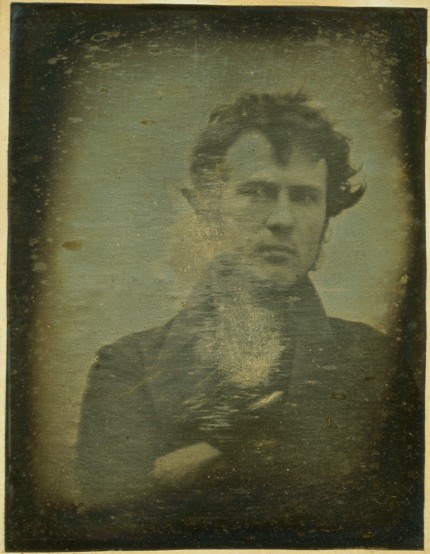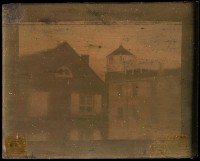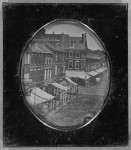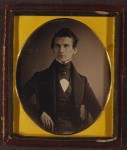Here it is:

Robert Cornelius took this picture of himself outside of his family’s lamp Philadelphia store in October or possibly November of 1839.
 Although there were reports that Louis Daguerre had devised a method to fix images captured by a camera obscura onto a metal plate as early as 1835, the daguerreotype was first announced in January of 1839 and the process released to the public on August 19th. After detailed descriptions of how to take daguerreotype were published in Philadelphia journals and newspapers in September and October, Robert Cornelius, who had a great interest in chemistry and worked for his father doing silver plating, was approached by inventor Joseph Saxton to create a light-sensitive silver-coated plate for use in daguerreotypy. With Cornelius’ plate, Saxton took the earliest known surviving picture in the United States on October 16th, capturing the round tower of the Philadelphia Central High School and the old Pennsylvania State Arsenal building at the corner of Chestnut and Juniper from the window of his offices at the US Mint.
Although there were reports that Louis Daguerre had devised a method to fix images captured by a camera obscura onto a metal plate as early as 1835, the daguerreotype was first announced in January of 1839 and the process released to the public on August 19th. After detailed descriptions of how to take daguerreotype were published in Philadelphia journals and newspapers in September and October, Robert Cornelius, who had a great interest in chemistry and worked for his father doing silver plating, was approached by inventor Joseph Saxton to create a light-sensitive silver-coated plate for use in daguerreotypy. With Cornelius’ plate, Saxton took the earliest known surviving picture in the United States on October 16th, capturing the round tower of the Philadelphia Central High School and the old Pennsylvania State Arsenal building at the corner of Chestnut and Juniper from the window of his offices at the US Mint.
 Cornelius was intrigued by the new technology and immediately set to doing his own experiments. His first subject was far more challenging than Saxton’s. Daguerreotypes required long exposure times of up to 15 minutes. Even the shortest exposures were at least three minutes, which made the medium less than ideal for capturing living, conscious beings. Schools and arsenals do photographers the courtesy of not even twitching once. Cornelius wanted to give it a go anyway, so he took his homemade camera — a box with an opera glass lens — into the yard behind the lamp store and there, in the daylight, he took a daguerreotype half-portrait of himself with crossed arms and tousled hair that wouldn’t look out of place in a fashion magazine today. He’s a little off-center, but I think it only makes him look more natural and less like he had to hold that pose for minutes on end. The lamp store, incidentally, was located on 8th Street between Market and Chestnut, just five blocks from the US Mint where Saxton took his first photograph.
Cornelius was intrigued by the new technology and immediately set to doing his own experiments. His first subject was far more challenging than Saxton’s. Daguerreotypes required long exposure times of up to 15 minutes. Even the shortest exposures were at least three minutes, which made the medium less than ideal for capturing living, conscious beings. Schools and arsenals do photographers the courtesy of not even twitching once. Cornelius wanted to give it a go anyway, so he took his homemade camera — a box with an opera glass lens — into the yard behind the lamp store and there, in the daylight, he took a daguerreotype half-portrait of himself with crossed arms and tousled hair that wouldn’t look out of place in a fashion magazine today. He’s a little off-center, but I think it only makes him look more natural and less like he had to hold that pose for minutes on end. The lamp store, incidentally, was located on 8th Street between Market and Chestnut, just five blocks from the US Mint where Saxton took his first photograph.
 After his first foray into daguerreotypy, Robert Cornelius caught the bug. In February of 1840 he opened a portrait photography studio and captured the likenesses of other sitters, wealthy clients and family and friends. He also published what is believed to be the first photograph in an advertisement in the Philadelphia Public Ledger. Very few of his works, only around two dozen, have survived. Thankfully his masterful selfie is among them.
After his first foray into daguerreotypy, Robert Cornelius caught the bug. In February of 1840 he opened a portrait photography studio and captured the likenesses of other sitters, wealthy clients and family and friends. He also published what is believed to be the first photograph in an advertisement in the Philadelphia Public Ledger. Very few of his works, only around two dozen, have survived. Thankfully his masterful selfie is among them.
Cornelius quit the photography business in 1843 and returned to work for the family’s lamp and chandelier concern where he had a very successful career building a better mousetrap, mainly lamps that ran on cheaper and more easily accessible fuels like pig lard rather than the prohibitively expensive whale oil that was still the default option when he began. Under his tenure the company became the largest lamp business in the country before they were eventually overtaken by other better-mousetrap-makers. Robert Cornelius retired a wealthy man in the 1860s.
What an amazing photograph.
I’m not say it’s great art, but it has an immediacy and a candid quality that wasn’t common in photos for another 100 years. And somehow Cornelius doesn’t even look “19th Century” (whatever that is).
I wouldn’t find it at all hard to believe that this was a modern digital photograph that had been passed through one of those software filters that renders an antique effect.
Agreed on all points. It looks like a fleeting moment captured, not like 5 minutes spent frozen in place.
Another very early “selfie” is of Henry Fitz, Jr. It is also thought to have been taken in 1839. Early photography is fascinating…the images capturing and saving little windows of time from so long ago and bringing them into the future for us to marvel over. I love looking at the clothing and hair styles of the old days and imagining the person in the photo getting dressed and ready that day for their portrait and traveling to the studio for what back then was a rather important event. What else did they do that day after having it taken? Did they like the photo? What would they think to know that the image they posed for that day would still be in existence so far into the future?
Henry Fitz, Jr. very wisely chose to keep his eyes closed to avoid the whole problem of needing to blink. That makes me wonder how Cornelius managed to have his eyes look so sharp.
I also like to ruminate on the people in old photographs. It seems to me they would often have been considered a permanent piece of art work in the early days, just like a painted portrait. Something to hand down through the generations. I think the notion of disposability didn’t enter into the picture (yuk yuk) until photographs got a lot cheaper and easier to make.
I have a step uncle in law who swears he actually invented the selfie. There are older pictures of him – from bona fide film and or polaroid style cameras doing it. I don’t mean just pictures of him, but the actual technique of selfie-ing. Where the subject holds the camera in reverse to take pictures of himself and/or whatever group he was in.
Yeah, I’m going to have to agree with CinTam that your uncle is a bit late to that party. I’m guessing the selfie-technique selfies started happening as soon as cameras were made that could be held in hands rather than needing to be mounted.
Don’t know when your uncle was doing it, but the selfie technique was probably more common in the “old days” than one might think. Photographer Vivian Maier is known for her “selfies” from the 50s-60s and I have selfies from the 1980s taken with my old Minolta film camera. :yes:
http://www.amazon.com/dp/1576876624/ref=rdr_ext_tmb
Thank you for letting me know about Vivian Maier. What a magnificent talent. I’m so bummed that she just missed by a few months all the recognition she has now received.
He’s rather dishy too.
Oh my yes. I’m very glad he didn’t think to run a comb through his unruly mop before taking the shot.
I’ve always thought of Sarah Goodridge’s miniature painting of her breasts as a gift to Daniel Webster as the first selfie.
Beauty Revealed
Do you think he told her tits or gtfo?
Okay, I just had to look that one up. It was worth the effort, thanks!
They were very much worth immortalizing, no doubt about it.
That’s a very cool picture!
And, like others said, it lacks the stiffness you usually see in early portraits. The focus and detail are also remarkably good for such an early improvised camera, especially if you consider that, with the use of a sense there has to be a focal point and I understand from the story that he didn’t have the help of someone else to get the focus right…
I studies photography but I never came across these. I should add that the big ‘selfie hype’ hadn’t started yet at that point so maybe there was less of an interest in how far the phenomenon actually goes back.
We knew about self-portraits, of course, we made our own, we discussed the many ways in which photographers would do so and what could be expressed by that. But now with digital cameras are everywhere all the time, there are social media to share the images, everybody is doing it and there’s a new word for it. The ‘selfie’ has now become a thing in itself, a cultural phenomenon which makes us look at all those old self-portraits with different eyes. Are they what earlier generations of photography theorists and art historians (before the invention of photography lots of painters made self-portraits after all…) thought they were? Or are they selfies avant-la-lettre?
Lauriana, you are truly a philosopher at heart. :notworthy:
I was going to say that there is a significant distinction between the self-portrait, no matter what the medium, and the selfie because the latter is spur-of-the-moment, casual, uncomposed, but then I remembered recently reading an incredibly detailed list of elements necessary for a great selfie according to modern masters of the genre (Rihanna, several Kardashians, various other Instagram gurus) and now the foundations of my snobbery are crumbling. I blame your thoughtful comment for this disaster!
I quickly ran it through Photoshop, making a few adjustments. It more apparent it was taken outdoors once the levels have been corrected.
Oh, interesting. Could you upload your PS version somewhere and link to it?
Funny, I wonder the same things when looking at one of the oldies. Especially like Civil War pics or the old west.
I think period images can be so haunting. It’s no surprise we wonder about the sitters, especially the history lovers among us. :yes:
I think that’s a poisonous phrase and should have been stopped before it started.
It doesn’t just hurt women, it hurts men, too. Knock it off.
Well, had I actually directed it towards a person then I would accept your chastisement with more alacrity. Do you think that any use of it at all no matter what the context is inherently poisonous?
“Worth it”?
You’ve got a LOT of growing up to do.
Seriously.
I do have a fairly wide-ranging sense of humor, including the puerile, sexual and scatalogical, as any number of historical poop, sex toys and pornography articles can attest to, but all in all, I’m pretty content with my level of maturity. I don’t think expressing appreciation of Sarah Goodridge’s self-portrait of her breasts is childish. Is there something in the “worth immortalizing” phrase that you find particularly offensive? It’s used in regards to everything from a beautiful nude to a great turn of phrase to a bygone architectural wonder.
+1
I think in this case that the word “tits” better reflects the content of the painting than “breasts” does. And this playful sexuality connects us with Goodrdge and Webster as people like us.
Indeed. It amuses me to think that if you wanted to sext your lover in 1828, you had to be capable of painting exquisite miniatures on ivory.
needing to be mounted?
GOOD HEAVENS, MAN! DO YOU KISS YOUR MUM WITH THAT MOUTH!?
:chicken:
Only on the cheek, I swear!
( . )( . )
Boobies!!! 👿
Now that’s maturity right there. 😉
It’s probably a good thing that she didn’t go for an ‘Origin of the World’ sort of artwork as Gustave Courbet did later in the century.
How did he manage not to blink for several minutes? If he had to run into the frame, how is the image not blurred? He has the assured gaze of someone quite accustomed to having their photo taken and there does seem to be something oddly contemporary about him. I’d love to hear from an expert in the field. When was this daguerreotype discovered? Is it possible to prove its authenticity? Is there a movie on the way?? Hmmm .
Whoever and whenever, he is hauntingly beautiful.